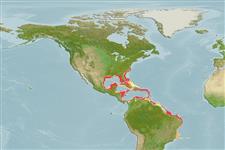Common names from other countries
Environment: milieu / climate zone / depth range / distribution range
Ecologie
Rifbewoner; diepteverspreiding 1 - 192 m (Ref. 83934). Tropical; 35°N - 21°S, 90°E - 32°E (Ref. 83435)
Western Atlantic.
Length at first maturity / Size / Gewicht / Leeftijd
Maturity: Lm ? range ? - ? cm Max length : 3.4 cm DL mannelijk/geslacht niet bekend; (Ref. 83435)
Maximum depth from Ref. 109264. This species is found in intertidal and offshore coral reefs, particularly on algae, coral, gravel, rock, sand, shells, and sponge habitats (Ref. 83934).
Life cycle and mating behavior
Geslachtsrijpheid | Voortplanting | Kuitschieten | Eieren | Fecundity | Larven
Members of the order Archaeogastropoda are mostly gonochoric and broadcast spawners. Life cycle: Embryos develop into planktonic trocophore larvae and later into juvenile veligers before becoming fully grown adults.
Rodríguez-Sevilla, L., R. Vargas and J. Cortés. 2009. (Ref. 83934)
Status op de Rode Lijst van het IUCN (Ref. 130435)
Status bij CITES (Ref. 108899)
Not Evaluated
Not Evaluated
Gebruik door de mens
| FishSource |
Tools
Meer informatie
Leeftijd/Grootte
Groei
Lengte-gewicht parameters
Lengte-lengte parameters
Morfologie
Larven
Abundantie
Internet-bronnen
Estimates based on models
Preferred temperature
(Ref.
115969): 21.1 - 27.5, mean 25.2 (based on 160 cells).
Prijsklasse
Unknown.
